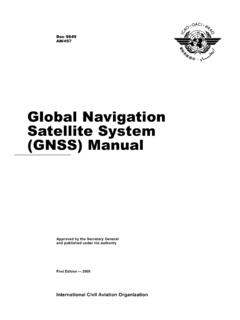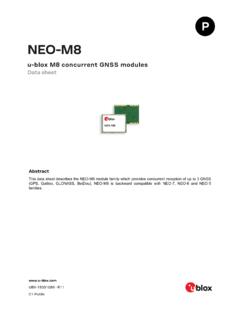Transcription of Real-Time GNSS Data Transmission Standard RTCM 3
1 IGS Workshop 2006 Perspectives and Visions for 2010 andbeyond , May 8-12, 2006, ESOC, Darmstadt, GermanyReal- time gnss data TransmissionStandard rtcm W bbena, Martin Schmitz, Andreas BaggeGeo++ GmbH30827 Workshop 2006 Perspectives and Visions for 2010 andbeyond , May 8-12, 2006, ESOC, Darmstadt, GermanyOutline rtcm Overview rtcm SC104 DGNSS standards rtcm Standard General Structure Raw data Format Compression Observation Types Transport Protocol Comparison with other Formats General Requirements for Standard data Formats Other Issues Control ProtocolIGS Workshop 2006 Perspectives and Visions for 2010 andbeyond , May 8-12, 2006, ESOC, Darmstadt, GermanyRadio TechnicalRadio TechnicalCommission for MaritimeCommission for MaritimeServicesServicesRTCM SC-104: Enabling standards thatRTCM SC-104: Enabling standards thatSupport Emerging Positioning and RelatedSupport Emerging Positioning and RelatedTechnologiesTechnologiesRudy Kalfus (SC-104 Chairman)Rudy Kalfus (SC-104 Chairman)Bob Markle ( rtcm President)Bob Markle ( rtcm President)Streaming gnss data Via Internet-SymposiumStreaming gnss data Via Internet-SymposiumFrankfurt, 6 February 2006 Frankfurt, 6 February borrowed from.
2 IGS Workshop 2006 Perspectives and Visions for 2010 andbeyond , May 8-12, 2006, ESOC, Darmstadt, GermanyRTCM founded in 1947 asRTCM founded in 1947 State Department State Department AdvisoryCommitteeCommitteeNow an independent membershipNow an independent membershiporganizationorganizationIGS Workshop 2006 Perspectives and Visions for 2010 andbeyond , May 8-12, 2006, ESOC, Darmstadt, GermanyRTCM StandardsRTCM StandardsRTCM supports development of standardsRTCM supports development of standardsand regulations of and regulations of International Maritime Organization (IMO) International Maritime Organization (IMO) International Telecommunications Union (ITU) International Telecommunications Union (ITU) International Electrotechnical Commission (IEC) International Electrotechnical Commission (IEC) International Organization for Standardization (ISO) International Organization for Standardization (ISO) rtcm standards WorkRTCM standards WorkIGS Workshop 2006 Perspectives and Visions for 2010 andbeyond , May 8-12, 2006, ESOC, Darmstadt, GermanyEuropean Telecommunications standards InstituteEuropean Telecommunications standards Institute(ETSI)(ETSI)Comit International Radio-Maritime (CIRM)Comit International Radio-Maritime (CIRM)Cospas-SarsatCospas-SarsatInternat ional Association of Aids to Navigation andInternational Association of Aids to Navigation andLighthouse AuthoritiesLighthouse Authorities (IALA) (IALA)International Hydrographic Bureau (IHB)International Hydrographic Bureau (IHB)National Marine Electronics Association (NMEA)National Marine Electronics Association (NMEA) rtcm LiaisonsRTCM LiaisonsIGS Workshop 2006 Perspectives and Visions for 2010 andbeyond , May 8-12, 2006, ESOC, Darmstadt, GermanyRTCM MembersRTCM Members22 Government Agencies from 7 nations22 Government Agencies from 7 nations56 Manufacturers from 14 nations56 Manufacturers from 14 nations41 Others.
3 41 Others:AssociationsAssociationsService ProvidersService ProvidersDesignersDesignersVessel Owners/OperatorsVessel Owners/OperatorsTrainersTrainersIGS Workshop 2006 Perspectives and Visions for 2010 andbeyond , May 8-12, 2006, ESOC, Darmstadt, GermanySC104: Differential Global NavigationSC104: Differential Global NavigationSatellite Systems (DGNSS)Satellite Systems (DGNSS)SC109: Electronic ChartsSC109: Electronic ChartsRTCM StandardsRTCM Standardsused internationallyused internationallyIGS Workshop 2006 Perspectives and Visions for 2010 andbeyond , May 8-12, 2006, ESOC, Darmstadt, GermanySC101: Digital Selective Calling marineSC101: Digital Selective Calling marineradiosradiosSC110: Emergency BeaconsSC110: Emergency BeaconsSC112: RadarSC112: RadarSC117: Electromagnetic InterferenceSC117: Electromagnetic InterferenceResistance for marine radiosResistance for marine radiosSC119: Maritime Survivor Locating DevicesSC119: Maritime Survivor Locating DevicesRTCM regional StandardsRTCM regional Standardsused in USAused in USAIGS Workshop 2006 Perspectives and Visions for 2010 andbeyond , May 8-12, 2006, ESOC, Darmstadt, GermanyRTCM SC-104 DifferentialRTCM SC-104 DifferentialGNSS StandardsGNSS standards Originally set up in 1983 to develop standards for DGPS toOriginally set up in 1983 to develop standards for DGPS toachieve 5 meter accuracy navigation & positioningachieve 5 meter accuracy navigation & positioning Version 1 was replaced by Version 2, when implmentationVersion 1 was replaced by Version 2, when implmentationproblems turned up (1990)problems turned up (1990) Version added Real-Time Kinematic (RTK) messages toVersion added Real-Time Kinematic (RTK) messages toprovide decimeter accuracy of short ranges (1994)provide decimeter accuracy of short ranges (1994)
4 Version expanded diffrential operation to GLONASS,Version expanded diffrential operation to GLONASS,provided ancillary RTK messages (1998)provided ancillary RTK messages (1998) Version added several new messages to improve RTK,Version added several new messages to improve RTK,radiobeacon broadcasts, use of Loran-C (2001)radiobeacon broadcasts, use of Loran-C (2001)IGS Workshop 2006 Perspectives and Visions for 2010 andbeyond , May 8-12, 2006, ESOC, Darmstadt, GermanyRTCM SC-104 DifferentialRTCM SC-104 DifferentialGNSS StandardsGNSS standards Inefficiency of Version 2 messages led to the developmentInefficiency of Version 2 messages led to the developmentof an improved format of an improved format more efficient, higher integrity, and more efficient, higher integrity, andsimplicity of development simplicity of development Version (2004) Version (2004) Version 3 primariliy aimed at improving RTK, supportingVersion 3 primariliy aimed at improving RTK, supportingnetworked RTKnetworked RTK Current Working Groups: Network RTK, Internet Protocol,Current Working Groups: Network RTK, Internet Protocol,Coordinate Transformations, Reference Station IntegrityCoordinate Transformations, Reference Station IntegrityMonitoring, GLONASS, GalileoMonitoring, GLONASS, Galileo New Proposed Working Group: EncryptionNew Proposed Working Group.
5 EncryptionIGS Workshop 2006 Perspectives and Visions for 2010 andbeyond , May 8-12, 2006, ESOC, Darmstadt, GermanyRTCM SC-104 DifferentialRTCM SC-104 DifferentialGNSS StandardsGNSS standards While the Commission was originally set up to addressWhile the Commission was originally set up to addressmaritime standards , DGNSS standards are applied world-maritime standards , DGNSS standards are applied world-wide to land and maritime positioning systemswide to land and maritime positioning systems One strength of the SC-104 Committee is that paritcipatingOne strength of the SC-104 Committee is that paritcipatingcompanies benefit from world-wide standards , thus arecompanies benefit from world-wide standards , thus aremotivated to develop themmotivated to develop them Participants include vendors, service providers andParticipants include vendors, service providers andgovernment agencies from around the worldgovernment agencies from around the world standards are subjected to performance andStandards are subjected to performance andinteroperability testing prior to adoption and publicationinteroperability testing prior to adoption and publicationIGS Workshop 2006 Perspectives and Visions for 2010 andbeyond , May 8-12, 2006, ESOC, Darmstadt, GermanyRTCM General Structure Scope.
6 OSI Standard reference model Application Layer (brief discussion) Presentation Layer ( data Field and Message Definition) Transport Layer (Message Framing, CRC) data Link Layer (no specifications, up to service providers) rtcm -NTRIP Physical Layer (no specifications, up to service providers) Version 3 Database Architecture Definition of data Fields (DF) (fixed length, variable length text) data Fields not on Byte Boundaries for Maximum Compression Definition of Message Types (MT) composed of data Fields Format designed for Broadcast TransmissionIGS Workshop 2006 Perspectives and Visions for 2010 andbeyond , May 8-12, 2006, ESOC, Darmstadt, : DF ExamplesDF009DF003DF #The GPS L1 Pseudorange field provides the rawL1 pseudorange measurement at the referencestation in meters, modulo one lightmillisecond(299, meters). The GPS L1 pseudorangemeasurement is reconstructed by the userreceiver from the L1 pseudorange field by: (GPSL1 pseudorange measurement) = (GPS L1pseudorange field) modulo (299, m) +integer as determined from the user receiver'sestimate of the reference station range, or asprovided by the extended data set.
7 If DF012 isset to 80000h, this field does not represent avalid L1 pseudorange, and is used only in thecalculation of L2 mL1 Pseudo-rangeThe Reference Station ID is determined by theservice provider. Its primary purpose is tosupport multiple reference stations within asingle data link Transmission . It is also useful indistinguishing between desired and undesireddata in cases where more than one service maybe using the same data link IDData Field NotesData TypeDFResolutionDF RangeDF NameIGS Workshop 2006 Perspectives and Visions for 2010 andbeyond , May 8-12, 2006, ESOC, Darmstadt, : MT Example72 TOTAL8uint8DF013L1 CNR8uint8DF012 Integer L1 PseudorangeModulus Ambiguity(8 MSB s of Pseudorange)1bit(1)DF001 Reserved3bit(3)DF011L1 Lock time Indicator20int20DF010L1 PhaseRange L1 Pseudorange24uint24DF009L1 Pseudorange1bit(1)DF001 Reserved1bit(1)DF008P(Y)/CA Code Indicator6uint6DF007 Satellite IDNOTESNO. OFBITSDATATYPEDF # data FIELDT able : Contents of the Satellite-Specific Portion of a Type 1002 Message, Each Satellite GPS Extended RTK, L1 OnlyIGS Workshop 2006 Perspectives and Visions for 2010 andbeyond , May 8-12, 2006, ESOC, Darmstadt, GermanyRTCM Message Groups, Message Types (MT) Observations GPS L1MT: 1001, 1002 GPS L1/L2MT: 1003, 1004 GLONASS L1MT: 1009, 1010 GLONASS L1/L2MT: 1011, 1012 Station CoordinatesMT: 1005,1006 Antenna DescriptionMT: 1007,1008 Auxiliary Operation InformationMT: 1013 Supplement # 1: (to be decided in May 2006) GPS EphemerisMT: 1019 GLONASS EphemerisMT: 1020 Network RTK (MAC)MT: 1014-1017 Proprietary MessagesMT: 4088-4095 IGS Workshop 2006 Perspectives and Visions for 2010 andbeyond , May 8-12, 2006, ESOC, Darmstadt, GermanyRTCM Raw data Messages Observables (GPS, SBAS and GLONASS).
8 Pseudorange (C/A,P1(Y),P2(Y),P2(Y) cross correlated,Correlated P/Y) PhaseRange (L1,L2) Carrier to Noise Ratio (L1,L2) [dB-Hz] Observable Related Parameters Pseudorange Smoothing Parameters (Smoothing Interval ) Loss of Lock: Lock time Indicator GLONASS Frequency Number Compression Method L1 Pseudorange Modulo 1ms (2ms GLONASS) or Full L1 Pseudorange L2 Pseudorange L1 Pseudorange (+/- m) L1 PhaseRange L1 Pseudorange (+/- m + Overflow) L2 PhaseRange L2 Pseudorange (+/- m + Overflow)IGS Workshop 2006 Perspectives and Visions for 2010 andbeyond , May 8-12, 2006, ESOC, Darmstadt, GermanyRTCM Raw data Messages Observables MT 1001,1002,1009,1010 L1 Only MT 1003,1004,1011,1012 L1+L2 MT 1001,1003,1009,1011 PR Modulo 1ms, no CNO Requires Receiver (or Software) Clock Steering (+/- 100 ns) MT 1002,1004,1010,1012 Full PR,2 Codes, 2 Carriers, 2 CNO Clock Steering required, although not necessary (atomic clocks?) Transmission of 3 or more signals (Code,Carrier,CNO) possible throughcombination of messages (1004,1002), but currently not allowed Pseudoranges may be smoothed or unsmoothed No simultaneous Transmission of both Bandwidth Requirement (10 SVs, MT 1004) 1368 Bits (171 Bytes) per Epoch Maximum data Rate: 1000 HzIGS Workshop 2006 Perspectives and Visions for 2010 andbeyond , May 8-12, 2006, ESOC, Darmstadt, GermanyRTCM : Antenna Description Message Reference Station ID (DF003) Antenna Descriptor (DF030) IGS Naming Convention for Antenna Type Antenna Setup ID (DF031) To be changed every time a change occurs at the station thatcould affect the antenna phase center variations (PCV) Antenna Serial Number (DF033) Alphanumeric Characters, allows unique identification of individualantennas in conjunction with Antenna Descriptor IGS Workshop 2006 Perspectives and Visions for 2010 andbeyond , May 8-12, 2006, ESOC, Darmstadt, GermanyRTCM.
9 Reference Station Coordinates Reference Station ID (DF003) Antenna Reference Point (ARP) Coordinates ECEF-X (DF025) ECEF-Y (DF026) ECEF-Z (DF027) Antenna Height (ARP) above Marker (DF028)IGS Workshop 2006 Perspectives and Visions for 2010 andbeyond , May 8-12, 2006, ESOC, Darmstadt, GermanyRTCM Transport Layer 8 Bits Preamble 6 Bits reserved 10 Bits Message Length 0-1023 Bytes of data (the Messages Defined in Presentation Layer) 24 Bits CRC QualComm CRC-24Q Probability of undetected errors < 2-24 for channel bit errorprobabilities < Workshop 2006 Perspectives and Visions for 2010 andbeyond , May 8-12, 2006, ESOC, Darmstadt, GermanyReal time Format Features/Requirements rtcm IGS Observables for all SignalsYes/Nox ObservablesResolution Code (Pseudorange)2 cm? Phase (Phaserange) mm? Doppler-? Loss Of Lock Indicator (Lock time )LockTime? Carrier to Noise Ratio (Standardized ?) dbHz? Channel Number-? Wavelength Factor-? time Tag Resolution 1 ms? data Rate<1000 Hz1Hz min. CompressionYes?
10 IGS Workshop 2006 Perspectives and Visions for 2010 andbeyond , May 8-12, 2006, ESOC, Darmstadt, GermanyFormat ComparisonRTCM + P1 + P2C/A + P1 + P2C/A + P1 +P2PR mCarrier PhaseL1 + L2L1 + L2 + LAL1 + L2 + mm---+Doppler--0x7f-02+CNOL1+L2C/A + L1 + L2+S1,S2,SACNO db-Hz1 Loss of LockLock time -Slip Flag1 ms1 ms10 mBINEX0x7f-00 PseudorangeC/A + P2(Y) orP1(Y) + P2(Y)LA + L2 orL1 + L2 Carrier Cycles= cyles= mmWavelength Factor1, Rx Rx TagResolution100 nsNavTimeClock Steering(100 ns)1 nsIGS Workshop 2006 Perspectives and Visions for 2010 andbeyond , May 8-12, 2006, ESOC, Darmstadt, GermanyOther Issues Currently not Supported by RTCM3 Is there need for a Standardized Receiver Control Protocol ? Rx Setup: (Elevation, data Rate,..) Reset data Retrieval, .. Is there need for data Encryption ? Kinematic and Stop and Go Support More Meta- data Receiver Type / Serial Number / FW Versions, .. Support for Standardized Meteorological data /Sensors Support for Products State Space Parameters (Orbits, Clocks, Biases, Iono, )IGS Workshop 2006 Perspectives and Visions for 2010 andbeyond , May 8-12, 2006, ESOC, Darmstadt, GermanySummary provides gnss Raw data in a Compressed Format rtcm is the major gnss Standard for Real time Dataexchange Directly supported by most Geodetic Receivers Supported by Service Providers Flexible Structure, easily extendable is a good choice for a Standardized Raw data Format IGS requirements not fulfilled yet, may be considered by SC104 IGS should become a member of rtcm Next rtcm SC104 Meeting: May 11-12, 20







